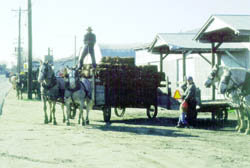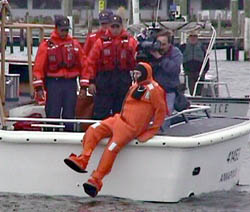| Daffy with Spring
photo by Scott Dine
I wandered lonely as a cloud
That floats on high o’er vales and hills
When all at once I saw a crowd
A host of golden daffodils
—from “The Daffodils” by William Wordsworth
Could Wordsworth only make it to London Town’s 20th annual daffodil show next week, he’d see more than a host of them: try 400 specimens.
“They run the gamut from the most primitive wildflower type to the seriously bred, ruffly ones,” says London Town director Greg Stiverson.
Many of these daffs veer sharply from the classic yellow trumpet sorts common to these parts. “I didn’t realize there were so many kinds of daffodils,” says Stiverson. “Last year’s show blew my socks off.”
In the category known as ‘doubles,’ a rose-like cluster of petals fill the daffodil’s center, where a trumpet or cup would usually sprout. Others, like the Surfside, sport a corona of petals that flare back as if driven by a stiff sea breeze. And in place of a single bloom, some daffodils bear two, three or — in the case of the Erlicheer — 20. Daffodils come as tiny as a half-inch or span a whopping five inches, as does the saucer-sized Fortissimo.
Were it indeed the London Town crowd of daffodils Wordsworth wandered into “lonely as a cloud”, he would have been hard-pressed to describe them as simply “golden.”
“I’d always thought daffodils were just white or shades of yellow,” Stiverson says. “Some are actually a gorgeous, almost shocking pink.”
Also red, orange and every two or three-tone combination imaginable. Take the Firestreak: “A bold orange with red flames bursting from the center of a star-shaped, yellow-edged cup,” says the White Flower Farms’ Bulb Book. Or the red-and-white striped Honolulu, which imparts a “spicy tropical fragrance,” according to the White Flower Farmers.
Even when it comes to basic yellow, you’ll have to slice it pretty fine for today’s breeders. “What kind of yellow?” they might ask. Is it, for example, the egg yolk yellow of the Premeur, saffron like the Las Vegas, the butter yellow sported by the Buff Belle or possibly the Cheddar cheese yellow of the Holland Sensation? To accurately describe his immortal daffodils as “golden,” Wordsworth would have had to be gazing upon a host of Mondragons or King Alfreds.
These and a host — nay — crowd of daffodils from all the world over will flock to London Town to be displayed in two sections: as arrangements in one, and as an exhibit of pristine horticultural specimens in the other. “One flower per vase, in row after row of all different categories,” says Stiverson. Adds show co-chair Marie Colter of the Federated Garden Clubs of Maryland: “This way people learn all the types of daffodils, and maybe identify what’s in their own yards.”
The club has chapters all over the state. “We band together with our best specimens and bring them to London Town for official judging,” she says.
How do you judge a daffodil? Colter runs down the main points: “We’re looking for perfect blooms with petals free from splits,” she says. “We also look for the correct pose of the flower.” Some varieties — like Pink Pride — tilt slightly upward like a tiny peach satellite dish. Others such as the W.P. Milner (which, by the way, features corkscrew petals and a pleated trumpet) “nod.” Still others hang “pendulously,” as the Bulb Book puts it.
After judging, the daffodils open to the public April 12 (1-5pm) and April 13 (10am-4pm). Wander as a cloud o’er the vales and hills of London Town to see the many daffodils. And if you see one (or more) you like, “We’re bringing catalogues people can order from,” says Colter. “We’ll also have a list of where people can go to find their favorites.”
Passages Casper Venter
Casper Venter saw Chesapeake Country with new eyes. T ransplanted in midlife from Johannesburg, South Africa, he saw gold where we saw trash. ransplanted in midlife from Johannesburg, South Africa, he saw gold where we saw trash.
“Goods that seemed to be unusable — reject telephones, old computer cases, sheet plastics, grocery bags — we’d process it. As they came out of the grinders and pelletizers, they’d be ideal for remarketing,” Venter told Bay Weekly in November, 1998. Before his move to Maryland in 1998, Venter had owned a recycling operation in Johannesburg.
But the recycling entrepreneur had no time to amass a fortune while ridding Maryland of mountains of plastic trash.
Casper Venter died of sudden heart failure March 23, at the age of 56, at the home he shared with his wife, Elaine Brennan, in Arnold.
“One Man’s Trash,” Casper Venter’s look at American recycling, appeared in Vol. VI No. 45 (Nov. 12-18).
Timeless Tobacco
photo by Connie Darago
Have I entered a time warp? It is 2000, a new millennial year, not 1890 … right? not 1890 … right?
If you were traveling the southern corridor of Rt. 5 in Charles County through Hughesville March 29, you’d have wondered.
A glorious sun peaked over the horizon, casting blinding glares from the metal Quonset hut warehouses.
A state trooper, with flashing lights, sat on the road edge hoping to slow passersby.
Huge draft horses hunkered down as they backed wagons loaded with burdens and bales of tobacco to the loading docks.
Charles County’s motorcycle police wandered about, directing traffic and enjoying a little sotweed cigar style.
Horses in full harness stood like giant statues hitched to electrical poles and empty wagons.
Farmers Tobacco Warehouse owner Raymond Guy ran about making last minute preparations.
And rattles of steel-wheeled flat wagons and clicking hoofs of draft horses intertwined with the whines of the Chevys, Fords, and Chryslers as commuters headed for high-tech city jobs — and the Amish for the first millennial tobacco market.
Tobacco has been called Maryland’s living link to history. Amish Market Day proves just that.
“This is the most incredible thing I’ve ever seen,” said Bobbie Langley of Goldsboro, North Carolina, who travels the tobacco circuit to keep tallies of tobacco markets.
Bobbie’s right.
The scenes are straight from the days of Little House on the Prairie as Amish men sporting long flowing beards and small straw hats and women wearing full-length apron-covered dresses and black-brimmed bonnets bring their crops to market in wooden wagons drawn by horses.
Tobacco is hard work. It takes about 225 man-hours to produce one acre of tobacco from seedbed to sale on the auction market. Perhaps more for the Amish who use no modern farming equipment.
The work doesn’t stop there.
“We were here until 10:30 last night rearranging the floor to make room for the Amish crop,” said Janice Schultz, a St. Mary’s farmer who spends every day at the three-week market.
It takes a lot of room for the Stoltzfus family tobacco.
Eleven members — Aaron, Ben, David, Eli, Gideon Sr., Gideon Jr., Jacob, John L., Anderson, Leo and Sam: grandfathers, fathers, sons, grandsons, brothers, nephews, and cousins — offered their tobacco for sale Wednesday at the warehouse.
Seventy-one-year-old St. Mary’s tobacco farmer Eddie Kennetts brought a smaller crop to market.
“I’m disappointed in the market. I haven’t seen it this bad in 10 years,” said Kennett. “In an average year the market floor is cleaned out as quick as farmers bring it in. This year there’s one buyer who set the price and he wants one type of tobacco. There’s not much of it, but plenty of the other.”
Schultz spoke more optimistically.
“The Europeans are buying the very best primo tobacco first and paying top dollar. Last week’s average was $1.84 a pound,” said Schultz. “We have to be patient. The rest will go and get a good price.”
Kennett is not so sure.
“I brought 40 bundles to market last week,” said Kennett, pointing to the tally sheet he’d retrieved from his pickup for this purpose. “I’ve sold one bundle for $1.75 a pound. They say the rest is seconds and offered me 30 cents a pound. That won’t pay for the gas it took to transport my crop to market.”
So it’s back to reality.
There was no time warp. It’s 2000, not 1890, and as much as tobacco links the past and the present, the truth is that a farmer bringing a crop to market by wagon or truck has no guarantee it will sell.
By midmorning, 1.5 million pounds of tobacco had sold at the Farmers Tobacco Warehouse for an average price of $1.77 per pound.
Gilchrest Suited to Save Lives
official Coast Guard photos by Lieutenant Toni Gay
U.S. Rep. Wayne T. Gilchrest would not ordinarily be swimming in the Kent Narrows this time of year, when water temperatures are still about 52 degrees. But the environmentally conscientious congressman was wearing an immersion suit, so he was able to endure the chilly waters.
These bright orange life-saving suits, called ‘Gumby suits’, keep whoever wears them afloat and protect them from hypothermia until help arrives.
“It seems to me this suit is an effective tool in saving lives,” said Gilchrest, stepping out of the water.
Immersion suits are required by the U.S. Coast Guard aboard all commercial fishing vessels over 36 feet during winter months. Originally, all commercial fishing vessels were required to have on board buoyant survival crafts, which costs about $2,000.
The suit Gilchrest modeled costs about $300.

But watermen still say the cost is a burden. Moreover, watermen believe they should be exempt from carrying the suits because of the relatively small size of the Chesapeake. And, because many watermen work in fleets, help is usually close by. They also argue that the suits take too long to put on in an emergency.
Countering their objections brought Gilchrest to the water. “I think the suits are a reasonable compromise, and I hope watermen will agree that their lives are worth the investment,” he said, zipping up.
The job of a waterman is one of the most hazardous in the United States. They work in unpredictable storms and raging, frigid waters. Falling overboard, capsizing or sinking are everyday threats.
“I’ve seen needless loss of life due to lack of equipment,” said Coast Guard and Department of Natural Resources Police veteran Mickey Courtney. “The gear is very necessary.”
The Coast Guard estimates that at least 80 commercial fishermen die each year. Immersion suits have cut the number in half in some areas of the country and are credited with saving hundreds of lives, Coast Guard officials said.
Cutting the Calvert Commute
photo by Connie Darago
Calvert Countians like Cherie Kittle find an office away from work at the Calvert County Telecommuting Center.
Chances are if you live in Calvert County, you don’t work there. Instead you pay for your semi-rural splendor with a nasty commute to a far-away job. pay for your semi-rural splendor with a nasty commute to a far-away job.
“Sixty percent of our residents leave the county each day,” says Linda Vassallo, director of Calvert County’s Department of Economic Development.
Thanks to telecommuting, Richard Bragunier is one Calvert countian who can stay away from the office and still enjoy the fruits of his labor.
For Bragunier, a full-time computer specialist with the Department of Transportation in Washington, D.C., away from the office means working three days a week at the Calvert Telecommuting Center in Prince Frederick — which is a mere 13-mile, 15-minute drive from his Dunkirk home.
On the two days that Bragunier has to drive to work, it takes him at least 50 minutes to muscle his way into D.C.’s cramped and sometimes pockmarked streets to reach his office, a good 32 miles away. Do the math and you can see why Bragunier favors working at the center, where he says he can accomplish everything — except maybe having lunch with his colleagues.
“Working here is just like working in the office. I just dial into the mainframe, and I’m in. This is a perfect environment for work,” says Bragunier, a three-year telecommuting veteran.
Two other telecommuting centers operate in the region: one in Waldorf and the other in Laurel.
These satellite offices are equipped with the latest computer software and office equipment. “They’re models for the workplace of tomorrow,” says Danette Campbell , who directs Telecommuting Centers for the College of Southern Maryland.
To link the centers with their telecommuters’ office systems, the centers employ technical people who can load — and unload — software into the centers. That innovative arrangement was discovered by Cherie Kittle, a telecommuting employee of the Federal Highway Administration of the Department of Transportation.
Kittle, who has to be in constant touch with her co-workers via e-mail, says Calvert center staff “customized” one of the computer units for her. “Now I can access anything [in the office] from here,” she says.
Telecommuting even once a week as she does “really helps a lot, especially when I have to buckle down and do some analytical work,” Kittle says.
“I like the quiet atmosphere and the privacy. There are fewer distractions here,” says Kittle, who has 18 months of telecommuting experience tucked under her belt. “Working here is really a morale-booster.”
Centers operate on a grant from the U.S. General Services Administration, so federal workers who use them enjoy a hefty discount: $54 per month for one day a week at the center. Who shoulders the bill? The concerned federal agency, which, Campbell explains, has a budget for this type of expenditure.
Government workers who want to telecommute more than the time allotted by their office can pay their own way — one day at a time.
“We don’t charge by the hour,” Campbell quips.
Other employers and workers pay more steeply: $108 per month for telecommunting once a week. “Considering the time and energy you will save and the benefits you will experience, this is still reasonable,” Campbell says. The Calvert center is actively promoting the benefits of telecommuting — more productivity with less stress and congestion.
“We think of ourselves as a quality of life broker,” Campbell says.
If you fit into the other side of this picture, Calvert County wants to know.
The county’s economic development office has posted a short 11-question survey on the department’s website. “We want to know how far they’re going and where they’re working,” Vassallo says.
Aside from measuring interest in telecommuting, Vasallo hopes to attract some of the businesses to which Calvert residents travel so far. “If we get enough responses from the same workplace, that’s a company or agency we’ll go after aggressively,” she says.
Imagine working in the same county you inhabit. As a Calvert countian you can make this dream come true: Log onto the county’s department of economic development website at www.co.cal.md.us/cced to fill out their fast and easy survey. Or wait for a hard copy to land in your mailbox.
“We just want to make life better here in Calvert County,” says Vassallo. “We’d also like to clear some cars off Route 4.”
Learn more about telecommuting: 800/933-9177 x 7628.
—John Viado with Christy Grimes
Way Downstream …
At New York University, students can truthfully say this subject stinks. In the course called “Garbage and Gotham: The Anthropology of Trash,” they will do some of their work at the Fresh Kills Landfill …
Massachusetts provides another junky story this week. Starting April 1, the state became the first in America to ban electronic junk from landfills. The reason? Lead from computer screens, television sets and the like can seep into the groundwater …
In South Africa, a musical competition called the Dunhill Symphony of Fire was canceled last month after conservationists persuaded authorities that a pair of rare black eagles nesting nearby would be disturbed. It wasn’t even rock ‘n roll; the event was a production in classical music …
Our Creature Feature comes from Shelbyville, Ill., where the sad demise of Harold ‘Bud’ Brunken prompted a diversion into the twisted fates that can befall the human animal.
Brunken was spraying weeds from a golf cart at the airport last weekend when a plane piloted by a man named Jimmy Stewart crashed from the sky on top of him. At the time, Brunken, 66, was keeping up the airport grounds in return for flight lessons. His obit in the Shelbyville Daily Union April 3 began: “Bud Brunken took his last flight to be with the Lord Saturday.”
Copyright 2000
Bay Weekly
|